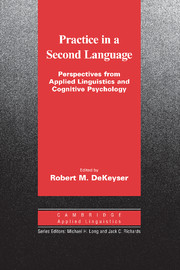Book contents
- Frontmatter
- Contents
- List of contributors
- Series editors' preface
- Introduction: Situating the concept of practice
- I: FOUNDATIONS
- II: INSTITUTIONAL CONTEXTS
- Chapter 5 A cognitive approach to improving immersion students' oral language abilities: The Awareness-Practice-Feedback sequence
- Chapter 6 Second language education: Practice in perfect learning conditions?
- Chapter 7 Meaningful L2 practice in foreign language classrooms: A cognitive-interactionist SLA perspective
- Chapter 8 Study abroad as foreign language practice
- III: INDIVIDUAL DIFFERENCES
- Conclusion: The future of practice
- Glossary
- Index
- References
Chapter 6 - Second language education: Practice in perfect learning conditions?
Published online by Cambridge University Press: 27 January 2010
- Frontmatter
- Contents
- List of contributors
- Series editors' preface
- Introduction: Situating the concept of practice
- I: FOUNDATIONS
- II: INSTITUTIONAL CONTEXTS
- Chapter 5 A cognitive approach to improving immersion students' oral language abilities: The Awareness-Practice-Feedback sequence
- Chapter 6 Second language education: Practice in perfect learning conditions?
- Chapter 7 Meaningful L2 practice in foreign language classrooms: A cognitive-interactionist SLA perspective
- Chapter 8 Study abroad as foreign language practice
- III: INDIVIDUAL DIFFERENCES
- Conclusion: The future of practice
- Glossary
- Index
- References
Summary
Introduction
In this chapter, second language acquisition (SLA) will be defined as the acquisition of a language other than the mother tongue that plays a prominent role in the environment of the language learner. Second language acquisition is commonly distinguished from foreign language learning (FLL), which takes place in settings where the target language plays no major role in the community, although the difference between the two is relative rather than absolute.
For second language learners, opportunities to learn the L2 and practice using it potentially arise in informal circumstances on the street as well as in the L2 classroom. This chapter will explore to what extent these two contexts give rise to different learning experiences in order to draw conclusions on how L2 classrooms may best serve the needs of L2 learners. The chapter will suggest that, even though the L2 classroom cannot offer L2 learners the opportunity to practice using the target language in “real operating conditions” (Johnson, 1988), it may offer the learners the opportunities for practice under perfect learning conditions, provided the L2 classroom (a) combines a focus on meaningful interaction with a focus on form, (b) allows opportunities for elaborate and repeated practice, and (c) allows the learners to use the L2 in an affectively “safe” environment.
Instructed and informal second language learning
Learning a second language outside a classroom, for instance while conversing with neighbors on the street or with colleagues in the workplace, is typically called “natural.
Information
- Type
- Chapter
- Information
- Practice in a Second LanguagePerspectives from Applied Linguistics and Cognitive Psychology, pp. 161 - 179Publisher: Cambridge University PressPrint publication year: 2007
References
Accessibility standard: Unknown
- 4
- Cited by
